Justin Robinson's Blog, page 13
July 31, 2015
Yakmala: Flashdance
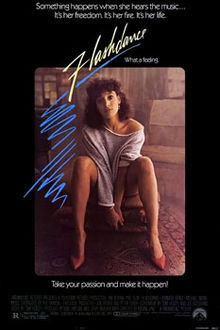
The neck hole was that big for her giant ‘80s hair.
In 1983, everybody saw Flashdance. Fucking everybody. Well, not me, because I was too young, but everyone else. It captured the zeitgeist — hell, it created large chunks of it — of the transformation of the grimy early ‘80s into the recognizable neon-drenched hairpocalypse we all know and presumably love. I missed it, and then never got around to seeing it, especially as it dropped off the cultural radar and featured none of the things that normally get me to see movies: aliens, cyborgs, and baseball-playing clowns. When I finally sat down to watch it, I found out that it is completely bugfuck insane.
Tagline: Take your passion and make it happen!
More Accurate Tagline: Take your passion, and 33% of you will make it happen!
Guilty Party: Adrian Lyne directed this thing, and Joe Eszterhas wrote it. This is what happens when bad meets evil. Or, at least, when creepy uncle meets guy who drives an ice cream truck and doesn’t own pants. The only question here is, who is sleazier? According to the IMDB (which is never wrong), Lyne wanted the heroine to have a backstory that included her being molested. Eszterhas, finding the one part of his soul that wasn’t stained with the semen of runaways, objected. That’s right. Lyne beat Eszterhas in a good old-fashioned Sleaze-Off, which is the equivalent of beating Batman at anything.
Synopsis: Alex Owens (Jennifer Beals) is a welder in Pittsburgh, which basically looks like Starling City before Ollie got back. While she spends her days in what might be a pipe-fitting plant (it’s never actually said), her mountains of hair just waiting to catch an unattended spark, she spends her nights at Mawby’s, a working class bar that somehow also hosts an avant-garde cabaret.
One night, while she does her routine in high heels and gets water dumped on her (if you’ve seen any shot from the movie, it’s that one), her boss Nick Hurley (Michael Nouri) catches sight of her and is instantly smitten. He begins to creepily stalk her, even following her home one night. He does this by driving literally three feet behind her while she bikes home, presumably to give her the sensation that she’s about to get run down at any second.
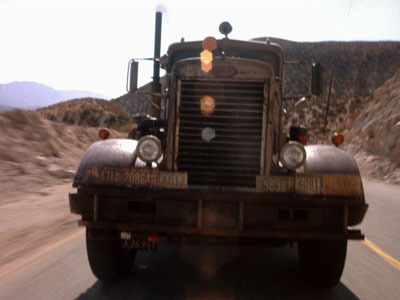
Nick used to date Dennis Weaver.
Oh yeah, Alex is supposed to be 18. Actor Michael Nouri was 37. So, yeah, her 20-years-older boss is hunting her like the last white tiger.
Alex wants to become a full-time dancer at the ballet. Which is just… seriously? She doesn’t do a single bit of ballet. Not at any point in the whole movie. Sure, ballet is dancing, but so is b-boying, which she does more of than ballet.
This idea, of working-class dreamers, is what could loosely be called a theme in the movie. Other than Alex, there are a couple others who follow their dreams sort of. First, her friend Jeanie, who waitresses at Mawby’s and wants to become a figure skater. Then there’s Jeanie’s boyfriend, short order cook and virulent racist Richie, who wants to be a comedian. While Jeanie flames out at a performance, Richie actually leaves for LA at one point, only to come back like a scene later, having failed. Which, glad we took the screentime for that. Richie’s act entirely consists of Polish insults. Richie is a man of deep, unexamined hatred.
There’s also an evil strip club called Zanzibar’s, which is like down the street from Mawby’s or something. Run by Johnny C. (Lee Ving, who you know from either Clue or the punk band Fear), he sleazes around trying to recruit Alex and Jeanie to dance. While he’s the closest thing the movie has to a bad guy, he’s pretty much the perfect stand in for Lyne and Eszterhas. He manages to get Jeanie after her disastrous skating incident, but Alex pulls her out of there.
Alex’s romance with Nick never stops being creepy, either. Eventually, someone checks their watch, realizes we’re about at the ninety minute mark, and decides to wrap this thing up. Nick gets Alex an audition with the ballet, she flips out on him for pulling strings but goes anyway. At the audition she literally does every kind of dance other than ballet, and gets in. And her dance double (and her jumping double, and her breakdancing double) are all really obvious. Roll credits.
I seriously have no fucking idea what happened.
Life-Changing Subtext: If you want to get ahead in this life, you have to date the boss.
Defining Quote: Alex: “Did you know that the smallest penis ever measured was 1.1 inches?”
Johnny C.: “You are some pair of cunts, you know that?”
Joe Eszterhas, ladies and gentlemen!
Standout Performance: Cynthia Rhodes plays Tina Tech, one of the other dancers at Mawby’s. About 95% of her dialogue is her just ranting about whether or not “he’ll call.” I might be out on a limb here, but I’m fairly certain Joe Eszterhas has no fucking idea of what women might say to each other. Rhodes is positioned as a plucky best friend, and since the comic relief is Richie — who’s about as funny as a blitzkrieg — she ends up getting more laughs. So, like, one. One half of a laugh.
What’s Wrong: The initial cut of the movie was something like two hours and twenty minutes. The studio heads and the time, Michael Eisner and Jeffrey Katzenberg, insisted it be cut down to the theatrical running time of 95 minutes. While this is good for my sanity, the plot was one of the things that got cut out. (Or not, it’s possible there never was a plot and I’m desperately trying to find sanity that was never there at any stage.) Lyne and Eszterhas looked to be making some kind of epic about dreams. What they got was a haphazard collection of scenes. Granted, those scenes are pretty terrible, but maybe they would make more sense in context. Pretty sure a director’s cut of this movie would violate the Geneva Convention, though.
Flash of Competence: The soundtrack is excellent. If you like early-‘80s cheese you can dance to, it doesn’t get much better.
Best Scenes: On a date with Nick, it’s abundantly clear Alex has never even seen a lobster before. She eats this thing like a goddamn caveman.
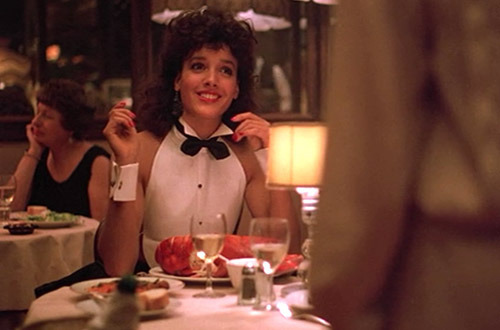
Also, she doesn’t know how shirts work.
Earlier in the film, she takes Nick back to her place. It’s a cathedral-like loft space that could comfortably fit literally every human being we see in the movie. This is when she puts on a sweatshirt, and in front of Nick (who can be seen physically resisting the urge to go “huminahumina”), she whips her bra off underneath it. This whole time, she’s got her legs spread, with only the sweatshirt blocking Nick’s view of her kidneys. It seems like it’s supposed to be her unconcerned with showing off her body, since she does it at Mawby’s, but it comes off like a young woman entirely unaware of sexuality driving a (much) older man crazy. In other words? Gross.
Transcendent Moment: Any time one of the dancers at Mawby’s takes the stage, the movie jumps tracks into delirious insanity. I don’t know what these women think is sexy, but it can best be described as “non-Euclidean.” These performances are really only dances in the loosest definition of the word, the way sulfuric acid is, technically, a “beverage.” These women get on stage to exorcise the gibbering demons that haunt them every time they close their eyes. And people wonder why Zanzibar’s is popular.

An unaltered still from one such performance. Yep, an evil clown who lives in graph paper.
In a final bit of madness, apparently David Cronenberg was offered the chance to direct. There is no word for how excited I would be to see that version of the movie. “The flesh… the flesh compels me to dance…” In the meantime, all we have is this oddity from the early ‘80s, proving people were much weirder back then.
Filed under: Projected Pixels and Emulsion, Yakmala! Tagged: Adrian Lyne, Cynthia Rhodes, Flashdance, Jennifer Beals, Joe Eszterhas, Michael Nouri, Yakmala!

July 24, 2015
Lifetime Theater: Seeds of Yesterday
I get obsessed with strange things. What usually starts as an ironic interest, say, in Scandinavian symphonic metal or Stephenie Meyer’s four book treatise on the desirability of an abusive relationship, can sometimes morph into, if not sincere admiration, something approaching bemused appreciation. No, this is not my long-winded way of telling you all I’ve turned the corner and am now Team Edward. I’ve aimed a little higher in my obsessions: noted Southern Gothic madwoman VC Andrews.
It’s probably unfair to compare Andrews and Meyer, but people loved comparing Twilight to Hunger Games and Harry Potter and that never felt entirely fair either. I kind of lump them together in the sense that in my generation, the Dollanganger books were the reading material of choice for young women on the cusp of puberty the same way the Twilight books were for a generation or two later. And yes, I’m saying this makes my generation objectively better. Suck it, time.
This week, I’m reviewing the final installment of Lifetime’s Dollanganger adaptations. It’s not quite with a heavy heart, but I’m not ready to leave these behind. I just love these Aryan crazies and their no-boundary households. Sadly, Lifetime chose not to adapt the final book in the series, Garden of Shadows, which is the gritty origin story of Ellen Burstyn’s character from Flowers in the Attic. I like to think this was an artistic decision, as Garden was written either partially or entirely by her long term ghostwriter Andrew Neiderman after Andrews died the previous year. Andrews has put out more posthumous material than Tupac.
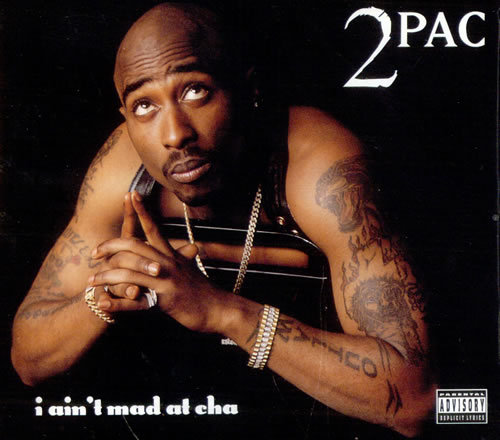
The VC Andrews of rap.
The reality, that Lifetime wasn’t getting the ratings it wanted, is probably closer to the truth. This is a real shame because Seeds of Yesterday is the best installment since Petals on the Wind. How does it achieve this lofty praise? Why, being fucking insane from front to back.
All artistic pretense is gone from the series by now. Chris and Cathy are portrayed by the same actors as If There Be Thorns, making these two the only ones to reprise those two roles. The rest of their kids have been aged up. Jory is now the perfect golden boy, the toast of the New York ballet, and married to ballerina Melodie. Bart is a creepy businessman, who spends most of the movie doing an impression of a sociopathic version of Christian Grey. So, you know, Christian Grey. Lastly, adopted daughter Cindy has grown into a babyfaced sexpot, which is just as creepy as it sounds. Seriously, the actress looks like some unholy combination of a heavily made up baby and a real doll. Naturally, Bart wants to fuck her. Bad.
But Bart is also super duper religious. All that stuff from John Amos has really made an impact. He idolizes Malcolm, complete with glowering portrait on the mantel (sadly, at no point are the eyes replaced by real ones), a name change to Bart Foxworth, and a combination of loathing for the family’s incestuous path and his weird conception (remember, Cathy conceived him in an adulterous revenge-affair with Corrine’s husband), and an Oedipal Complex deluxe. He spends every scene eye-fucking someone, usually either his mom or his sister. Which, ironically enough, makes him the perfect Dollanganger.
The plot kicks off when everyone comes home to a rebuilt Foxworth Hall for Bart’s birthday and to read Corrine’s will. Tragedy strikes almost immediately, like it’s hiding the bushes or something. Jory gets paralyzed in a ballet accident (seriously), and Bart waits about half a minute before sleeping with a pregnant Melodie. She pops out some twins and leaves, mostly because she can’t stand Jory anymore. All Jory does is complain that he can’t dance, or make love to his wife… in those exact words, multiple times. Maybe she got tired of that conversation. He attempts suicide and fails, which can’t be good on the ego, but then again, he didn’t try by dancing or making love to his wife.
Anyway, Jory hires a nurse to help him and the newborn twins. Bart pretty much instantly seduces her too. This guy, I swear. He’s all upset that he’s not getting his full inheritance at 25 and has to wait another ten years. Corrine even included a provision that if he’s institutionalized, he gets nothing. The Dollangangers are continually teetering on the edge of madness, so it’s a legitimate threat. Bart basically vacillates between trying to fuck Cindy and ranting about the sinfulness of everyone around him. It’s charming as hell.
Really, everyone comes off like they just went off their meds. Everyone. Anyone even tangentially related to the Dollangangers goes a little bugfuck. It’s like the makers of the movie realized they were making a soap opera — granted one with a literary pedigree — and then based every scene exclusively on outtakes of Tootsie. The alternate title of this is Mood Swings.
Chris dies in a throwaway scene, getting smooshed by a car after stopping to help a stranded motorist. This is how little the movie cares for one of the main characters of the entire series. “Hey, what should we do with Chris?” “I dunno… fuck it, car accident.” And before you point out the symbolic echo, since the entire plot kicked off when Chris’s father died in a car crash, fuck you. VC Andrews fucking loves car accidents. If she could have figured out a way to get an out-of-control semi into that attic, that’s how Cory would have bought it. Now I want to pitch Fast and Furious: Dollanganger Drift.
The movie is so insane that the fact Bart and Cindy wind up as married televangelists counts as a happy ending. Yeah, I was really concerned that the creepy misogynist philanderer wasn’t going to end up okay, but now I know he’s bilking old people out of their savings. The final scene has Cathy heading up to the attic again, because why not. She can hang out there. It’s not like she doesn’t know the space.
So what did we learn? If your son starts dressing like Christian Grey and talking like Rick Santorum, you’ve got problems. Always check the set before putting on a ballet performance. And never, ever drive anywhere.
Filed under: Projected Pixels and Emulsion Tagged: Creepy kids, Dollangangers, incest, Lifetime Theater, Seeds of Yesterday, televangelists, VC Andrews

July 17, 2015
A Lifetime Roundup
It’s the week after Comic-Con and I’m still recovering. It sounds to me like it’s time for everyone to learn a few lessons about life, taught by the network who took that as their name. That’s right. It’s time for Lifetime Theater.
An Amish Murder: Two great tastes that taste great together.
Anna Nicole: A tawdry sex symbol extends her 15 minutes of fame.
On Strike for Christmas: A passive aggressive protest is the best way to celebrate.
Playdate: New neighbors signal trouble for the perfect family.
Flowers in the Attic: The first installment of the Dollanganger saga lacks an identity.
Lizzie Borden Took an Ax: and might or might not have given her mother forty whacks.
The Bad Son: He doesn’t call, he doesn’t write, he murders redheads…
Death Clique: Lesbians are the biggest dangers facing today’s teens.
Petals on the Wind: The second installment of the Dollanganger saga ramps up the crazy.
Blue-Eyed Butcher: Lifetime subverts every trope in this insane true crime story.
The Craigslist Killer: That title is only barely accurate.
Talhotblond: One of the best Lifetime movies out there.
Drew Peterson: Untouchable: Rob Lowe is the King of Lifetime.
PopFan: Lifetime does Stephen King.
The Assault: The cheerleader, the cheerleader, the cheerleader’s on fire!
Grumpy Cat’s Worst Christmas Ever: We’re through the looking glass here, people.
Big Driver: Lifetime does Stephen King, only this time with royalties.
Foreclosed: Jamie Kennedy vs. Marlee Matlin.
Amanda Knox: Murder on Trial in Italy: This whole country’s out of order!
Jodi Arias: Dirty Little Secret: Everyone is a jerk!
If There Be Thorns: The third installment of the Dollanganger saga gets weird.
The Nightmare Nanny: The middle-aged middle-class bogeyman.
A Deadly Adoption: Some of the funniest people on the planet get serious.
And as a special bonus, check out “An Axe to Grind,” an 8 episode podcast all about Lifetime’s bizarre The Lizzie Borden Chronicles, and featuring me!
Filed under: Projected Pixels and Emulsion Tagged: A Deadly Adoption, Amanda Knox: Murder on Trial in Italy, An Amish Murder, Anna Nicole, Big Driver, Blue-Eyed Butcher, Death Clique, Drew Peterson: Untouchable, Flowers in the Attic, Foreclosed, Grumpy Cat's Worst Christmas Ever, If There Be Thorns, Jodi Arias: Dirty Little Secret, Lessons, Lifetime, Lifetime network, Lifetime Theater, Lizzie Borden Took an Ax, On Strike for Christmas, Petals on the Wind, Playdate, PopFan, Talhotblond, The Bad Son, The Craigslist Killer, the lizzie borden chronicles, The Nightmare Nanny

July 10, 2015
Now Fear This: Insidious Chapter 2
She’s mostly worried about tall ghosts.
Even by my own nebulous and frequently-violated rules for this particular feature, Insidious was a weird choice. I can’t properly justify it, beyond the fact that I really enjoyed the film, especially as a departure from a pair of creators known chiefly for helping to bring torture-porn into the mainstream. I had a vague idea it might have been unpopular — an idea that I have been thoroughly disabused of — because of the writer/director team, and the fact that I am about as plugged into what is popular as the average octogenarian cave dweller. I have a similar belief about the sequel, Insidious Chapter 2, but then again, there’s been a Chapter 3 too.
Still, while most people praise the first installment, there are plenty who dislike the second. This is not too surprising, since it is the lesser movie. Yet there is plenty to recommend it, especially for genre fans willing to follow the flights of fancy of creators James Wan and Leigh Whannell. After all, this is the movie with time traveling ghosts.
Don’t worry. We’ll get there.
The film picks up right after the end of the first one — and seriously, if you’re reading this and haven’t seen the first one, stop right now and rectify that — with the aftermath of Josh (Patrick Wilson) and Dalton Lambert’s escape from the weird realm of The Further. As it turned out, Josh did not return to his body. It was the spirit of the weird old woman, a ghost what haunted him from childhood, a murderous entity whose first action upon her return to life was to kill helpful psychic Elise (Lin Shaye). As the Lamberts try to return to a sense of normalcy, Josh steadily deteriorates both physically and mentally from the pressures of playing skinsuit to a serial killing ghost. Wife Renai (Rose Byrne) and mom Lorraine (Barbara Hershey), call in both Specs and Tucker from the previous film, as well as a new psychic (and old friend of Lorraine and Elise’s) to help.
The fun part about this installment is how different it is from the first, yet logically a part of the same universe. The old woman, initially a creepy presence in the first, a detail to fill out both Josh’s backstory and set up the twist ending, gets her whole biography laid out. As it turns out, “she” is a misnomer. She’s actually a male serial killer in the Norman Bates mold, complete with overbearing mother. This killer, Parker Crane a.k.a. The Black Bride, carved a swath of death through Los Angeles until he attempted to curb his urges with self-castration. This landed him in the hospital, where he died under the care of young Lorraine and led to his first meeting (and implied obsession) with Josh.
In addition, the hauntings have not stopped. Renai is dogged by snatches of familiar piano music, and her daughter’s toys move around of their own accord. In a welcome twist, these turn out to be from Josh’s spirit, trapped in the Further, trying to warn his wife of danger. Ghost hauntings can be frightening and uncanny, so it’s refreshing to see them framed as genuine concern and a heroic effort on behalf of loved ones. Poor Renai is too traumatized to get it until too late.
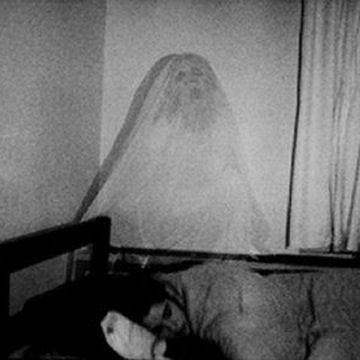
Hey, girl. Just looking out for you.
The time traveling stuff is the most common complaint, and I can’t say issues with it are wrong. Generally speaking, you’re allowed one weird thing in a movie. If your film has ghosts, it can’t also have werewolves, unless it has every other monster ever. So ghosts are fine. Ghosts plus demons are iffy, but since in the popular imagination they’re sort of kissing cousins, you’re getting a pass. Time traveling ghosts? No thank you.
Basically, the beginning flashes back to the night Elise first meets Lorraine and Josh. As a side note, young Lorraine is played by Jocelin Donahue, who remains my favorite modern ‘80s actress. Anyway, this night includes a few weird aspects of a haunting that can generally be chalked up to “ghosts are scary.” Later, as Josh and Dalton (having heroically returned to rescue his father) try to escape, they run into both this, and the events of the first film. What we find out was that some of the scary events were caused not by the various ghosts trying to get into Dalton’s empty skin, but Josh attempting to communicate with the other side across both time and space.
While part of me rebels whenever a filmmaker feels the need to explain a delightfully bizarre scene, another part enjoys this conception of purgatory. This is a place existing beyond death, so who’s to say it conforms with linear time? In fact, wouldn’t it be more frightening and alienating for those within to be able to see themselves alive? It adds a huge dimension for storytelling, and creates the potential for the kind of delicate tragedy horror movies can find so difficult to evoke. While Insidious Chapter 2’s exploration can best be summed up by Elise’s line, “So that’s what that was about,” there is plenty of space for potential sequels. Not that I expect any kind of high-minded consideration of non-linear time in a big-budget horror franchise. I’m just saying it’s there if they want it.
The first Insidious was a haunted house film featuring throwback images from the silent era combined with a postmodern genre savviness. The second dials both back and becomes more of a possession movie. In fact, the third act starts to resemble the finale of The Shining, a movie people seem pretty fond of. While I’m not placing them on the same level, Chapter 2 does grant context to Jack Torrance’s madness.
Insidious Chapter 2 is not as good as the first, and was probably doomed never to be. While this can be disappointing to those who were expecting the same level of innovation, it’s a mistake to dismiss this installment out of hand. There’s plenty interesting going on here and more to the point for we horror fans, it still has a few of the eerie scares so prevalent in the first.
Filed under: Projected Pixels and Emulsion Tagged: Barbara Hershey, Insidious, Insidious Chapter 2, James Wan, Leigh Whannell, Lin Shaye, Patrick Wilson, Rose Byrne

July 3, 2015
Yakmala: Battle of the Year
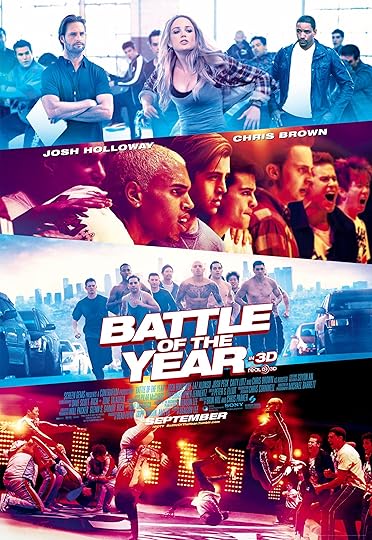
We lost a lot of good men on that hill.
I always thought of breakdancing as something existing in the increasingly graying depths of my youth in the ‘80s. I figured it went the way of crimped ponytails, wearing eight pairs of socks at once, or Walter Mondale. Turns out, breakdancing is still a thing people do, only now it’s called “b-boying.” Like anything with a vaguely homoerotic name, Hollywood turned it into a movie, with the sports-like competition of Battle of the Year.
Tagline: The world is watching
More Accurate Tagline: Maybe one guy is watching, and not for the reasons you’d hope.
Guilty Party: While this looks like the product of some cynical studio head glomming onto a trend and making a movie, this is actually a bit of a passion project. Director Benson Lee made a documentary called Planet B-Boy, and turned it into this movie. And just in case you didn’t know a documentary called Planet B-Boy existed, this film is only too kind to namecheck it for us, with one character rapturously referring to it as their Bible. That kind of unmitigated hubris is just what we need to turn a soulless studio picture into a bizarre misfire.
Synopsis: The Battle of the Year is the biggest breakdancing competition in the world, and it’s held in France. Despite America being the origins of both hip hop music, breakdancing, and the KFC Double Down, Team USA has failed to place for, like, ever. This panics hip hop mogul Dante Graham, whose entire company is built off the idea of hip hop being cool. It might not be the best business model.
His solution? Get his old buddy Sawyer (Josh Holloway), fresh off the island, and have him turn a team into champions. And yes, it’s not literally Sawyer from Lost, but fuck you, that makes this movie like 100% better. In the endless scenes of him haranguing his dancers, just once I wanted him to be like, “Live together, die alone!” or “You hear those whispers in the trees? The Others learned to b-boy from the Smoke Monster!”

The Smoke Monster defeats Mr. Eko in a high-stakes b-boy battle.
Sawyer kicks Dante’s team out, and holds an open audition to get the best b-boys from all over the country. He picks ones with issues that can be cheaply solved by the third act. They all have ridiculous aliases, and honestly, I’ve seen this thing twice and still can’t remember them all. It’s worth noting the “best” of them is Rooster, played by noted pile of semi-sentient shit Chris Brown.
At this point, Sawyer just decides to do whatever any hard-ass coach has done in any sports movie. There should have been a scene of him watching Hoosiers and taking notes. Anyway, these guys work out their issues — Rooster and MRA-hat Guy (not his real name) make peace, Homophobe and Gay Guy get along. And they’re a team! I guess, I mean, They’re dancing.
So it’s off to the Battle of the Year in France, where they face off against the best teams from all over the world. And the movie really drops the ball here. I was hoping to see some really over-the-top stereotypes of each country. Like the French b-boys dancing in berets while indifferently smoking, or the Germans having a disturbing fascist art installation and pooping on each other, or the Japanese all dressed like schoolgirls fighting giant monsters.
The team to beat is Korea, and wouldn’t you know it, the underdog USA ends up going up against them in the finals. The competition is super close, with the Dream Team losing by a single point because the screenwriters rented Rocky the night before. Hey, there’s always next year!
Life-Changing Subtext: If you work hard and get along, you’ll lose less badly.
Defining Quote: Sawyer: “It’s been an honor, Rooster.” A little context here. After the final cut was made, Rooster hurt his leg trying to perform a risky maneuver in slo-mo to impress a visiting b-boy. So as he’s limping out of the dorm, unable to go to the Battle of the Year, Sawyer says this.
I singled it out because no one has ever followed up “It’s been an honor,” with “Rooster.” Never. If you know a Rooster, his career opportunities are pretty much limited to petty conman, guy who buys beer for underaged kids, and prison rapist. That’s it.
Standout Performance: This belongs to Josh Peck, who plays Sawyer’s assistant coach, Franklyn-with-a-Y (he says this so much it qualifies as a catchphrase). The incredible thing about this performance is he manages to say every line like he’s not only deaf, but somehow also hard of hearing.
What’s Wrong: Despite the dancing, this is a sports movie. The key with making a good sports film is that the audience needs to understand the sport in question for the next hundred or so minutes. They never bother to explain b-boying, so it’s utterly impossible to know who’s doing better in any competition. Instead, the movie will cut to Sawyer, FwaY, and choreographer Stacy (Caity Lotz, before those White Canary dollars started rolling in), looking upset.
Flash of Competence: That said, some of the dancing is pretty cool. Unfortunately, Benson Lee has a crippling montage addiction. These quick cuts make the scenes less impressive and harder to follow. You hired breakdancers (and Chris Brown). Get a wide angle lens (and someone to kick Chris Brown’s ass).
Best Scenes: FwaY’s origin story is truly baffling. He’s mostly there for reaction shots. The camera cuts to him after nearly every significant moment, and he’s usually squinting into the middle distance, pursing his lips, like he’s really thinking hard about what that interviewer from Tiger Beat just asked him. Anyway, when he gushes over Sawyer about b-boying, Sawyer sensibly asks if he’s one. FwaY says no, citing his religion/ethnicity. “Jews. We’re rhythmically challenged. We’re stripped of our swag at the circumcision.” Which… what is he implying about the rest of the team? How much does he know?
While this movie is disposable crap, no one told the composer. When the (far more appropriate) dance music isn’t blaring, it reverts to an orchestral score. And this guy had to have thought he was scoring Schindler’s List or something. For a scene whose entire suspense is “Will Rooster, who we’ve known for 30 seconds, make the team?” this music sounds like it’s playing a last-second rescue of the little kids from Auschwitz.
When Caity Lotz shows up as the choreographer, everyone is utterly baffled she’s a woman. Is this a thing? Can women not breakdance? I really don’t see how. It’s not like she’s circumcised or anything.
Transcendent Moment: The movie transcends whenever it insists we take b-boying seriously. My favorite is right before the prelims when Team USA has to take on Team Russia to qualify (thus prompting the late second act meltdown all sports movies need). Sawyer hisses at his team: “The Russians are synchronized. Disciplined. Precise.” It sounded like he was ordering a tank advance into Stalingrad.

Hitler never prepared his men for Russia’s slick b-boy moves or awesome gun-related teamwork.
In many ways, Battle of the Year is the successor to classics like Breakin’ 2: Electric Boogaloo. Only instead of the modest goal of saving a community center, this one opts for the venal pleasures of money and glory. I thought the ‘80s was the materialist decade.
Filed under: Projected Pixels and Emulsion, Yakmala! Tagged: b-boy, Battle of the Year, breakdancing, Caity Lotz, dream team, Josh Holloway, Winning, Yakmala!

June 26, 2015
Lifetime Theater: A Deadly Adoption
There’s an element of hubris in my reviewing Lifetime’s most recent release, A Deadly Adoption. By the time this post is published, more virtual ink will be spilled over this than any Lifetime movie ever. Yet I’ve carved out a regular feature on this blog for learning big important lessons from pop culture flotsam, and I can’t let the most buzzed-about Lifetime movie pass unremarked on.
When it leaked that Will Ferrell and Kristen Wiig were making a Lifetime movie, visions danced in all of our heads of the truly insane parody these two would come up with. The writer, Andrew Steele, the same guy behind Casa de mi Padre and Ferrell’s pitch-perfect send up of late-‘70s prestige miniseries The Spoils of Babylon, only cemented that. What we all forgot is that comedians, at their core, are trolls. They do things that make them laugh and nothing makes them laugh harder than an unexpected prank.
It’s pretty easy to see their intent. Ferrell and Wiig didn’t want anyone to know about A Deadly Adoption. The whole point of it was to be something people stumbled upon organically and wondered what the hell was going on, or at least when two of the funniest people alive would make with the comedy. By leaking, it turned into an event, which ironically enough made it a non-event. It was no longer an odd little curio randomly found by Lifetime stalwarts and bored people at home on a Saturday. Now it was two movie stars no doubt making a perfect parody of a Lifetime movie that would double as the must-see comedy of 2015.
But here’s the thing: they were not making a parody of a Lifetime movie. They were making a Lifetime movie.
And, to their credit, it’s nigh perfect. From subtle things like the bright lighting, the stagey direction, and the musical cues, to the more meta elements like stilted performances from aging stars. Even the script is Lifetime-exact, where a couple suffers an easily-filmed and light-on-the-stuntwork tragedy, and brings a younger and hotter woman into the house to help complete the family. She turns out to be insane (of course) and forces this mild suburban couple into a deadly confrontation. The biggest problem with the movie is its saggy second act, when the novelty has worn off and the plot machinations begin to take over. Which is a problem more than one Lifetime movie suffers from.
When the predictable “oh this is so crazy” response came out the next day, complete with listicles celebrating the most ridiculous moments, I came to one escapable conclusion: most people don’t watch as much Lifetime as I do. And I have to live with this. Seriously, that synopsis sounded as familiar to both of my readers as it did to me when it unfolded. Why? Because it’s the plot of The Nightmare Nanny. Almost exactly, down to the character beats.
I’m not trying to go all Lifetime Hipster on you, mostly because if that’s a thing that exists, I might need to drink a gallon of turpentine. What I’m saying is that I believe Ferrell, Wiig, and Steele watched all of these and more in an effort to hew as close to a standard Lifetime movie as possible. They were so close to the formula that A Deadly Adoption, produced in part by the mad genius behind Anchorman and The Other Guys, isn’t even in the top five most insane Lifetime movies I’ve reviewed.

This is what restraint looks like.
In fact, they’re so interested in playing it straight, Ferrell never gives one of his signature line readings. You know the ones, where he’s angry, upset, and maybe a little frightened by what’s going on around him. The closest he ever comes is when he periodically reminds his wife that their daughter Sully (named because they expect her to grow up into a beefy Bostonian stevedore, I guess), has a specific kind of diabetes. The jokes and homages are there, from the maddeningly vague awards for philanthropy that adorn Ferrell’s office, to Wiig’s organic fruit and bakery business, to the reassurance it’s all based on a true story. But they’re all subtle enough to miss, and targeted at those who understand the language of Lifetime.
The showiest performance belongs to Jessica Lowndes, who plays the dual-named (She turns out to be impersonating a woman she might have killed. See? Nightmare Nanny!) surrogate Bridget/Joni. Because she’s the crazy one, the nubile young woman invited into the house to wreck it, she’s allowed to go full Nicholson. She’s not bad, as these things go. A good Lifetime Villain Meltdown is a skill they can and should teach in acting classes.
The oddest part from the perspective of a Lifetime stalwart such as myself, is the fact that Ferrell is the star. Wiig is perhaps not as big a name, but she headlined a movie everyone still likes (Bridesmaids) and she delivers an unironically good performance in it, nailing both the big comedic moments and crafting a believable character. Yet Ferrell gets most of the hero parts. He rescues Wiig from a carbon monoxide trap in the garage (the shot of him holding her as the garage door rises is the movie’s best), overcomes his fear of water to pursue Lowndes after she’s kidnapped Sully (no doubt plying her with Natty Lite and Red Sox tickets), and even stands in the way of a speeding SUV. While it’s Wiig who ultimately kills the threat to her home, Ferrell is by far the more active of the two.
It’s also unusual in that Ferrell’s character actually does cheat on Wiig. After she lost the baby by falling into three feet of water — yes, ridiculous, but totally on par for Lifetime — Ferrell descended into alcoholism. He goes on a series of book tours which are apparently all in hilariously seedy bars. On one of these he meets and has sex with Lowndes, who of course gets pregnant and loses the baby. I’m guessing by falling onto a pond. Most of these movies are made with the reassurance that, don’t worry, no matter how enticing the young lady is in the house, no matter how much she may want to stake her claim, the man will remain true. While he was drunk, and Wiig forgives him, he did hit that.
So what did we learn? Don’t stand on rotten docks. Do a thorough background check on any hot young women you allow into your house. And always be familiar with the dangers of diabetic ketoacidosis.
Filed under: Projected Pixels and Emulsion Tagged: A Deadly Adoption, Diabetic ketoacidosis, Jessica Lowndes, Kristen Wiig, Lifetime, Lifetime Theater, Will Ferrell

June 19, 2015
Now Fear This: The Purge: Anarchy
The Inception gang got a little weird.
Perhaps the most frustrating aspect of being an exploitation fan is the squandered premise. Good low budget films tend to be made by people with bountiful imaginations, and this lends itself to high concepts. High concepts that are nigh impossible to service in the constraints of an exploitation budget, so you’re often left with the tried and true plots of home invasions, grimy revenge, and survival horror. As long as the shooting permits are cheap, or the locations grungy enough to be ignored, the movie can be made.
This is what made 2013’s The Purge so frustrating. A high concept and high budget exploitation picture — expensive enough to pay for recognizable faces like Ethan Hawke and Lena Headey — and yet it hit the same beats as your standard home invasion thriller. There was nothing precisely wrong with The Purge, but there was precious little to distinguish it from other movies like it. To make matters worse, with the vastly superior You’re Next in the rearview mirror, The Purge already felt redundant the instant it was released into the wild. Still, it made enough money to justify a sequel. Lucky us, James DeMonaco, writer and director of the first one, heard the criticism and gave us exactly what we wanted.
The premise of the franchise is the kind of gonzo insanity that makes for good high concept exploitation. The United States government has been taken over by a far right wing party called the New Founding Fathers of America. To combat rising crime rates, they set aside one night a year — March 21st to March 22nd — in which all crime is completely legal and called it the Purge. This orgy of violence allows the populace to exorcise its anger, frustration, and rage, and turns us into productive little citizens. Never mind that crime rates are actually falling, and this kind of organized chaos would result in entire cities being burned to the ground; it’s cool enough for at least one film.
If The Purge squandered this premise with a by-the-numbers remake of Assault on Precinct 13, The Purge: Anarchy does the exact opposite. This movie takes as many ways as this idea can be explored and does its level best to hit as many as it possibly can. It lurches deliriously through Mad Max-esque rolling gangs, to slavers rounding up others for profit, to rich people hunting for sport, to mercy-kills for money, to family squabbles turned bad. It felt like DeMonaco made a list of as many films as he could make on the back of this premise and decided that instead of making one, he’d make them all.
DeMonaco uses the lens of three different groups of survivors to tell the story. The first is a young couple (Zach Gilford of Friday Night Lights and Kiele Sanchez from Lost) right about to separate, who have their car sabotaged by a gang of masked men. The second is a mother and daughter (Carmen Egojo and Zoe Soul) who narrowly escape first a neighbor-turned-attempted-rapist and then a team of paramilitary soldiers operating out of a big rig. The last group is one man (Frank Grillo): a laconic badass with an arsenal of guns and a grim attitude. Unlike the others, he is out on the streets by choice, meaning he’s there to purge. Yet he saves them from danger and guides them through the violent streets as best he can, while still holding out hope he can extract revenge from the night.
The original Purge also suffered from a lack of a point of view. It seemed willing to satirize… something, but it never peered past violent youth and the hypocrisy of friendly neighbors. Anarchy now openly wears its intent. It lingers specifically on the wealthy, both their pre-purge ritual of prayer to the New Founding Fathers, and their eagerness to use their wealth to murder without any of the risks the poor must take. It’s a blatant depiction of the rich turning economic predation on the poor into physical predation, and with the ultra-wealthy only getting richer, it is a theme that resonates. Though the movie sees purging as a bad thing, it sees purging from the safety of one’s home or other fortified area to be even worse. If there’s a sin Anarchy can’t forgive, it’s cowardice.
Yet it never confuses bravery with bloodthirst. In a refreshing change from what one might expect, it’s established in dialogue that not enough people are actually killing to create the sort of order the purge is supposed to bring. If given the chance to murder without consequence, Anarchy states (correctly, in my view) that the majority of people would not do so. The big rigs, which prowl the streets with a trailer-full of paramilitary soldiers and a tripod-mounted minigun, are government-sponsored plants, there to keep up quotas by butchering entire apartment complexes. In fact, Anarchy sees mercy as the highest virtue. If Grillo’s character had not chosen mercy over vengeance, he would have died.
The film touches on themes of gender and race as well. The would-be rapist who corners Eva and Cali in their apartment goes on an extended rant in which he states that he feels he is owed them. While the circumstances are different, it’s easy to see those words in the mouth of a more immediate threat. The gang that threatens Gilford and Sanchez is either entirely or predominantly black, the film treading queasily in Death Wish territory, where heroic whites are beset by animalistic minorities. Yet later, all the worst purgers are as white as you get without being transparent. The most heroic scene in the film depicts a team of entirely African American freedom fighters mowing down white people with assault rifles. It doesn’t hurt that the leader is the great Michael K. Williams.
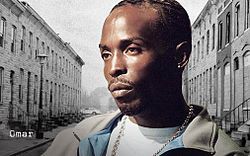
This is the top image if you google “Omar.” As it should be.
When I first saw the movie I joked that it plays like Grillo’s audition tape to be the Punisher. Unfortunately, that role has already been cast, and Grillo has the minor, if pivotal role of Crossbones. Still, it’s nice seeing what could be. While Ray Stevenson will always be my Punisher because of his one excellent outing, Grillo would have been a great choice for the modern Marvel stable.
The Purge: Anarchy is a modern exploitation picture, but it still manages to keep most of the nastiness of earlier generations. Even better, it has a conscience and a point, something that even the best examples of the genre are often sorely lacking.
Filed under: Projected Pixels and Emulsion Tagged: Frank Grillo, holiday bad ideas, James DeMonaco, Now Fear This, The Purge, The Purge: Anarchy

June 12, 2015
Yakmala: Judge Dredd
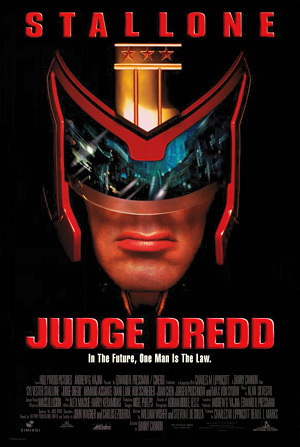
That’s Stallone’s warmest smile.
The Judge Dredd comic book occupies much the same place in my pop culture landscape as Doctor Who: a beloved British property of which I am only tangentially aware. So I have no dog in the fight over whether the 1995 Stallone vehicle is a good or bad depiction of a revered character who probably knows a crumpet from a biscuit. All I know is that it’s a shitty movie.
Tagline: In the future, one man is the law
More Accurate Tagline: The team up only 1995 could give us: Stallone and Schneider!
Guilty Party: Though we’re at the tail end of Stallone’s heyday, he still could get a movie greenlit based on little more than a glower and a few garbled vowels. It’s safe to say nothing happened on this movie set without Stallone’s at least tacit approval, so he’s at fault here.
Synopsis: We start with an opening crawl, which is never a good sign. It’s even a worse sign when that crawl has a narrator, like the filmmakers don’t even trust the audience to be able to read. And before you start complaining that they’re ripping off Star Wars, they hired James Earl Jones to read them. So they’re pretty much coming right out and saying it.
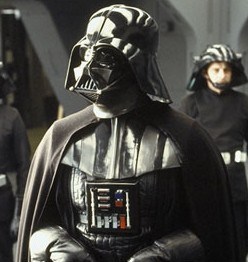
Uh, no. The bad guy is “Varth Dader.” Totally different.
Anyway, it’s some kind of apocalypse, everyone lives in Mega Cities (exactly what they sound like), crime is slightly less rampant than in a Death Wish movie, and to combat it, there are people who combine the roles of beat cop, judge, jury, executioner, and catchphrase tester all in one. These are the judges, and the most notorious of all of them is Judge Dredd (Stallone).
Of course, the movie doesn’t open with him. No, it’s 1995, and Hollywood was still under the mistaken impression we wanted to see Rob Schneider because we might have chuckled once at his Copy Guy character on SNL. He’s a recently paroled petty criminal — sort of an all-purpose hacker tech-guy — and while trying to get to his terrifying new housing, he gets caught up in a militarized riot let by James Remar of all people.
Dredd shows up and murders the living shit out of Remar, Remar’s gang, and anyone in the vicinity, then arrests Schneider for hiding out inside a recycled food robot. It’s a dick move.
Right around this time, Rico (Armand Assante doing a weird late-period Marlon Brando impression) escapes from superjail somehow. Turns out he’s a judge and he instantly gets his old gear and a giant robot from a pawn shop. That’s a really good pawn shop. Dredd also gets upset when he mentions to Judge Hershey (Diane Lane in her ‘90s career slump, between when she was ridiculously hot in the ‘80s and ridiculously hot for her age from the ‘00s until she dies) that he had a friend once and “judged him.” That line is delivered in a locker room and probably wasn’t supposed to come off as super, duper gay, but there you go.
Dredd gets framed for killing a journalist (played by the non-Busey bad guy in Lethal Weapon), and gets sentenced to prison only after his mentor, Max Von Sydow pulls some strings to commute the execution. For his trouble, Von Sydow gets exiled to the wasteland to teach mutant hillbillies the magic of zoning ordinances.
On the way to prison (they’re on Con Air from Con Air, and nothing will convince me otherwise), Dredd gets seated right next to Schneider. What are the odds? The mutant hillbillies — thought I was joking about those, huh? — shoot the fucking plane down and Dredd and Schneider get taken to the hillbilly lair to be eaten. This is baffling, because the plane is stuffed with already-cooked dead guys and we later learn the pilot was even alive, but the hillbillies take the only two people on the plane who weren’t grievously wounded.
So, it’s kind of their own fault when they get killed. Max Von Sydow shows up just long enough to help out before he dies. He confesses that Dredd was part of a cloning experiment called the Janus Project to make super-judges. Rico, Dredd’s best friend who he judged (he judged him so hard, and even though he knew it was wrong it felt so right), was the other one. Which explains why both actors are wearing weird blue contact lenses, only not really.
Meanwhile, back in Mega City 1, Hershey uncovers this mystery as well, while Rico and his patron Jurgen Prochnow, assassinate judges as part of a coup. Rico and his new assistant Joan Chen (only there so Hershey will have a woman to fight in the finale), are bringing back Janus! Which is a room full of frozen guys. What the fuck is with ‘90s Stallone movies and rooms of frozen guys?
Anyway, Dredd and Schneider break back into Mega City 1, hook up with Hershey, and confront Rico at his lab. It’s in the Statue of Liberty because why not? There’s a big fight. The heroes are triumphant. Dredd, now reinstated, kisses Hershey and wanders off to be the law.
Life-Changing Subtext: Thank goodness, fascism is saved!
Defining Quote: “I knew you’d say that.” Dredd says this so many times that it qualifies as a catchphrase, but without being particularly catchy. It’s like he hacked linguistics just to be a smug asshole.
Standout Performance: While Lane, Prochnow, and Von Sydow are all pros who can invest even the silliest line with a modicum of gravitas, they aren’t the standout here. No, that’s Armand Assante, who fucking gets it. He took one look at the script, nodded to himself, and probably even muttered, “Game on.” He then proceeds to deliver the most gleefully unhinged performance possible. He’s so hammy, I’m convinced he had an on-set baster.
What’s Wrong: Did you see that plot? Jesus Christ. L.A. Confidential had a more direct throughline.
Flash of Competence: The best parts of the movie are generally due to the time in which it was made. There’s actual blood, which feels like such a revelation. The FX are all practical, and though it leads to a flying motorcycle chase that looked bad at the time and looks worse now, there’s some charm to it.
Best Scenes: The hillbillies bear some mentioning. One of them is a giant mutant with one arm and a dial on his head. The dial controls his aggression or something. This seems like a terrible idea. It’s not password protected. There’s not even a sneeze guard. I feel like this thing must have led to more than one argument in the clan over the dinner table/murder room.
The recycled food robot is a legitimately good gag. It trundles down the hallway extolling the inhabitants of the slum to eat recycled food, with gems like, “it’s good for the environment and okay for you!” What’s recycled food? Probably best not to dwell.
Transcendent Moment: I singled out Assante’s performance, and there is a moment where he discovers an entirely new way to pronounce “law.” He and Stallone go back and forth, and Stallone hits him with, “You betrayed the law!” Assante’s line on the script would have read merely, “Law.” Perhaps “Law!” Instead, he invents a brand new vowel, and adds about six extra syllables. After he delivered that line, every walrus in the world showed up on the sound stage thinking they had a new king.

First, Assante must defeat the sitting king in hand to hand combat.
Judge Dredd is principally interesting these days as a look into a time before we understood how comic book movies should be made. Of course, if you’re Warner Brothers, that time is today.
Filed under: Projected Pixels and Emulsion, Yakmala! Tagged: armand assante, Comic Book Movies, comics, Diane Lane, Judge Dredd, Rob Schneider, sylvester stallone, Yakmala!

June 5, 2015
Lifetime Theater: The Nightmare Nanny
For a certain percentage of middle class women, nannies must represent the ultimate fear. The dawn of motherhood is supposed to represent the death of fuckability (although the enduring fascination for the MILF undermines this), while taking care of children is regarded as the pinnacle of traditional femininity. The problem is, in the modern economy you need at least two incomes to support anything approaching a middle-class lifestyle. The solution? Invite a much younger woman into your home whose only goal is to bond with your children in a deep and meaningful way, and will represent a temptation to your husband no matter much he might deny it. The nanny usurps every traditionally female role in the household, from sexually desirable nubile to nurturing caretaker.
That’s the exact fear that this week’s Lifetime Theater, 2013 The Nightmare Nanny traffics in. As though to underline it, they give star Ashley Scott (an It Girl for a short time about a decade ago), a pixie cut flirting with a Furiosa buzz, while titular nanny Mekenna Melvin gets the long, flowing, perfectly landscaped hair of a S.H.I.E.L.D. agent. I’ve talked a lot about the Lifetime network’s strange identity as the horror channel for middle-aged and middle-class women, and as though to support this thesis, it gave me the platonic ideal of what sort of movie this imaginary demographic might want.
It doesn’t stop with the simple idea of a wife and mother’s role being usurped by a younger, more attractive model either. It also plays with the anxiety of having a stranger live in your home and instantly give them access to your children. Really, The Nightmare Nanny wanted to scare the holy living shit out of some ladies, and god damn it, it’s going to do it.
Mekenna Melvin’s character, Amber Miller, goes insane when a car accident causes her to miscarry a daughter. She hears about a nanny job, when Annie (Ashley Scott) wants to go back to work to help clueless husband Ben (Kip Pardue) make ends meet. Amber, while outside talks to another applicant Julie (and gets her to come back to her car), and that’s the last we see of Julie. When Amber’s interviewing, guess what she’s pretending her name is?
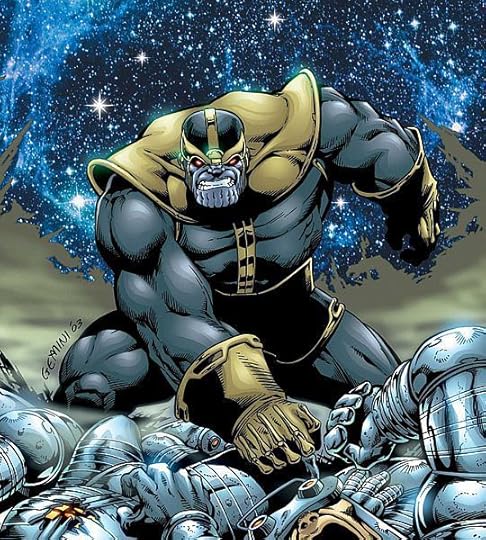
“Uh… Thanos. Thanos Johnson.”
Jenny, Annie and Ben’s daughter, absolutely loves Amber/Julie. Amber, for her part, just gets more and more creepy. It’s like she’s getting paid by the awkward moment. Basically, she wants a little girl to replace the one she lost — and she even calls Jenny Gabby, the name she was going to use for her daughter, in the third act — so a lot of what she does ends up making no sense in retrospect. There’s a scene where when Annie and Ben are away overnight, Amber tries on some of Annie’s lingerie (despite Melvin being almost a full foot shorter than Scott) and Annie’s locket. I don’t know much about jewelry, but I know lockets are important as shit. She ends up being caught by Elise, Ben’s sister and Annie’s employer, but Elise never mentions it.
It could be because Amber has her man Jake mug Elise in a parking garage. What’s baffling is that they don’t even show this scene. I suspect it would have been too scary, and it would have hurt Lifetime’s status as something you just sort of have on in the background while you do something else.
Anyway, everything comes to a head when Amber kidnaps Jenny and takes her off to this weird, white trash ranch. It’s supposed to be roughly four hours from LA (I think), and judging from the look, it’s either out near the Arizona border, or up around Bakersfield some place. For those unfamiliar with the area, those are great places to go if you ever want to get tetanus from a 7-11.

They also sell rickets, scurvy, and taquitos.
While the cops are useless, and Ben is useless but at least fairly supportive, Annie does some light detective work and unravels the whole case. Seriously, she solves this thing with one off-brand Google search. The only puzzle piece she doesn’t get is quickly supplied by the cops, who find the corpse of Julie Palmer up on Angeles Crest, and she’d been rotting away for two weeks. This means that the entire movie had been, to this point, two weeks. Not since Breaking Bad has there ever been a more ridiculous passage of time.
Annie heads up to Quartzfield (seriously, like one person laughed at that), and barges into the ranch, quickly finding one of Jenny’s stuffed animals. While Amber’s mom chases her off with a shotgun, Amber’s dad is just sort of belligerent and useless. You might be catching a pattern here. This is the most blatant example yet of the common Lifetime stereotype of the useless man. Oftentimes in these, a man will be evil, but this is the first time when all of the principal drivers of the plot have vaginas. I’m calling it an overall good thing, if only so I can see what women have to put up with in much larger, more expensive Hollywood movies. Hell, if I had paid $20 to see this, I’d be pissed. Let’s all just go watch Fury Road and awaken in Valhalla, eternal, shiny, and chrome.
Annie gets Ben to show up first, and they catch Jake at the local quickie-mart. We’ve seen this location like three times in the movie, so at this point, I’m imagining it’s the only store in the county. Jake flips on Amber instantly, and gives them the location of a bridge. Yeah, it turns out Amber has decided that this has all gone too far, and her only solution is suicide, possibly with a smidgeon of child murder. Annie, Ben, Jake, and the cops all converge on the bridge, where in the beginning of the movie Amber sprinkled Gabby’s ashes (and I don’t even know how that worked). They talk to Amber a little bit, but once Jenny’s found, Annie and Ben pretty much forget about the nanny. Who then leaps to her death.
In the end, Ben has left work (he wasn’t good at that anyway) and is a stay-at-home dad, while Annie works with Elise. What do they do? Oh, who knows? The entire thing is that vague “business” that we writers use when we have no idea what else to do. There’s talk of “presentations” and “accounts” and “pitches.” I’ll assume they’re accountants for college acapella groups.
So what did we learn? Don’t get a nanny! Either quit the job you supposedly need to support your family, or else let your children run free like the buffalo of old.
Filed under: Projected Pixels and Emulsion Tagged: adult fear, Ashley Scott, Kip Pardue, Lifetime Theater, Mekenna Melvin, Middle class terror, The Nightmare Nanny

May 29, 2015
Now Fear This: Josie and the Pussycats
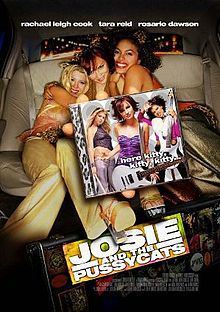
It’s like they couldn’t decide on a poster.
It’s an uncomfortable truth that for the vast majority of boys, the first sex symbols we fixate on are animated. It’s entirely possible this is true for girls as well, but I’ve never been a girl, so I don’t really want to speculate. Cartoons, usually some of the first entertainment we seek out and take ownership of, design characters that are impossibly attractive, and they’re having all kinds of cool adventures and being in bands and solving mysteries, and so it’s almost stranger if you never think to yourself, “Someday, I will marry Josie McCoy.”
In 2001, the news that not only would there be a Josie and the Pussycats movie, but it would star Rachael Leigh Cook — who was in my opinion the most beautiful woman in the world at that time — would have been greeted with the same enthusiasm if you told today me that bleu cheese is a cancer vaccine that also grants superpowers. Yeah… my priorities have changed a wee bit since then.
Of course, the biggest surprise about this is that not only, against all odds, was Josie and the Pussycats good, it’s still a movie I will happily watch over a decade later. It might seem odd to bring this specific film up in a series about mostly horror movies. It all comes back to the reaction to the Jem and the Holograms movie. Jem never had the same cultural cache for me that Josie did, but they both come from the same place. When the disastrous trailer hit the net, a lot of people came out of the woodwork to (justifiably) complain, but what I saw a lot of was comparing it unfavorably to my favorite movie about an all-girl band of furries. Hold on there, internet outrage machine. The Jem and the Holograms trailer can both be superficially similar to Josie and still be fucking awful. That doesn’t change Josie’s place as a fundamentally sweet, funny pop confection that is still well worth your time.
Josie charts the progress of the eponymous band from a trio of radically different young women each holding down multiple jobs (although one of Melody’s appears to be “standing by the side of the road with signs”), to their place as the biggest musical act in the world. This takes about a week of in-movie time, too. Along the way, they run afoul of a secret cabal who uses subliminal messages in pop music to turn modern teens into capitalist drones obsessed with chasing trends they don’t understand.
The main characters get introduced over the first (and in my opinion best) of the original songs. In a montage that’s half-credit sequence and half music video, you get the quick establishing characteristics of all three women (and some supporting personnel). There’s Josie McCoy (Cook), guitars and lead vocals, a hard worker with a cat fixation, Val (Rosario Dawson), bass, a big-hearted athlete who spends a lot of her time working for charities, and sweetly daft Melody (Tara Reid), drums, a space cadet who loves animals and her perpetually vacant expression. All three are great in these roles, and even as critics found little to like at the time, they usually singled out Dawson for her confident-yet-fragile turn. Also, the woman has not aged a single day. She might be the Highlander.
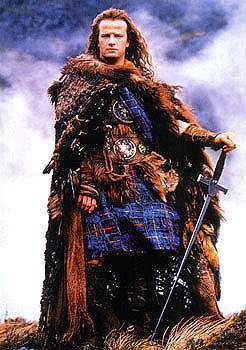
There can be only one, Dawson.
When the action opens, the biggest band in the world is Dujour, one of those boy bands that were really important right around then. These four, and the faces are familiar, hop off their private plane and immediately launch into their signature single, “Backdoor Lover,” which is exactly what it sounds like. Unfortunately for them, they have discovered something strange with their music and their manager, Wyatt Frame (Alan Cumming), has them killed in a plane crash (using the code phrase “Take the Chevy to the levee,” implying that this is done often enough to need a phrase, and throwing a good reference into the mix).
On the hunt for his next big act, Frame latches onto the Pussycats, and instantly remakes them into exactly what it wants. Val susses out that something’s wrong fairly quickly, although some of that is due to the fact that Frame really doesn’t like her, as the Pussycats are instantly rechristened to position Josie as a frontwoman. The others take a little more time, but eventually they’re all on the same page. Well, maybe not Mel. We’re not entirely sure she can read. Eventually, friendship has to rule the day, and reunited the ladies can beat the corrupt executives, play their triumphant stadium gig, and Josie can get the guy (who Mrs. Supermarket calls “Young James Spader”).
Josie and the Pussycats could have been hideously cynical, as it’s a self-aware, fourth wall-busting polemic on the evils of mindless consumerism. Fortunately, the movie retains a light touch with by concentrating on the friendship between the woman. The performances help as well, especially Cumming, Missi Pyle as the obnoxious Alexandra Cabot (“I was in the comic book,” she snits when her brother asks what she’s doing there), and Parker Posey as the deranged villain Fiona. While the character works just fine as she is — an insane villain — she’s a lot deeper than she looks at first glance. She’s a woman emotionally crippled by the very standards she’s working so hard to enforce. It’s an interesting, and subtle, depiction of the roles many female taste-makers have in propping up the patriarchy. Also, it’s Parker Posey and she can do more with an eyeroll than most actors can with a histrionic death scene.
Unfortunately for everyone concerned, Josie and the Pussycats was a flop. RLC, who had been on track for stardom after her turn in the truly bizarre She’s All That (seriously, it’s way stranger than you remember) got the biggest payday of her career and promptly was consigned to the indie crime film ghetto. This was the last appearance of appealing Tara Reid. Harry Elfont and Deborah Kaplan, who followed up their big hit (and all around solid teen comedy) Can’t Hardly Wait with this, have still not gotten another chance to direct a movie. While Josie is much better than its reputation suggests, it just never connected with its audience.
Part of that can be blamed on when it was released: April of 2001. This was the tail end of the country-wide malaise where we had nothing real to care about. Even then, we were already tired about caring about nothing. The candy colors and conspicuous consumerism look even more alien when viewed through a post-Great Recession lens.
Look past all that and you’ll find a fun little comedy about a trio of rockers who just want to make music in cat ears. Isn’t that all you really need? And “Backdoor Lover” will be going through your head for a week. That’s just a bonus.
Filed under: Projected Pixels and Emulsion Tagged: Alan Cumming, Can't Hardly Wait, comedy, I don't always do horror, Josie and the Pussycats, Now Fear This, Parker Posey, Rachael Leigh Cook, Rosario Dawson, Tara Reid




